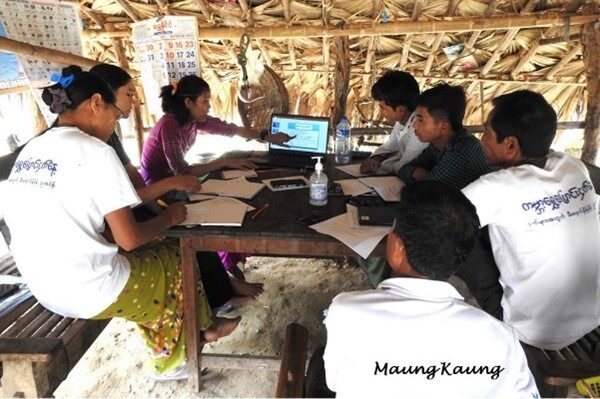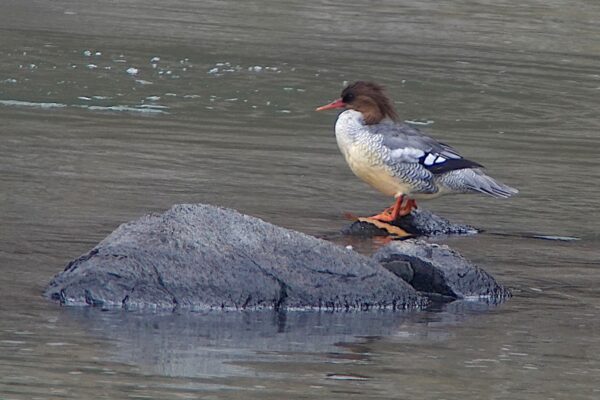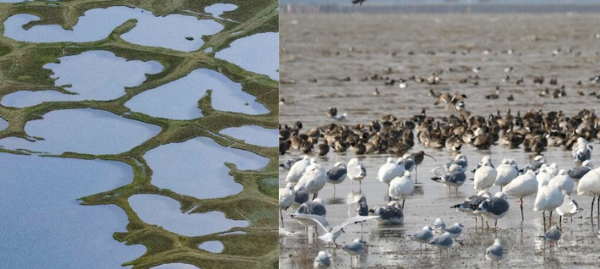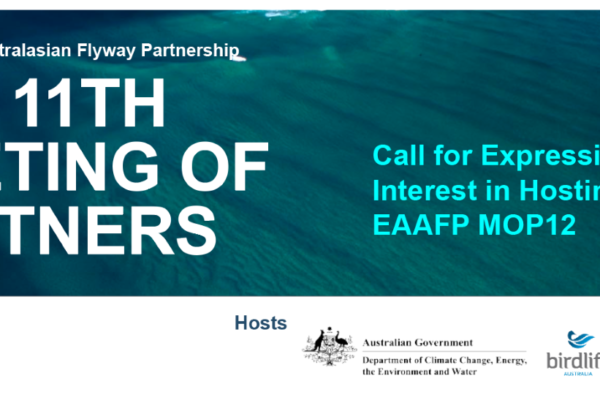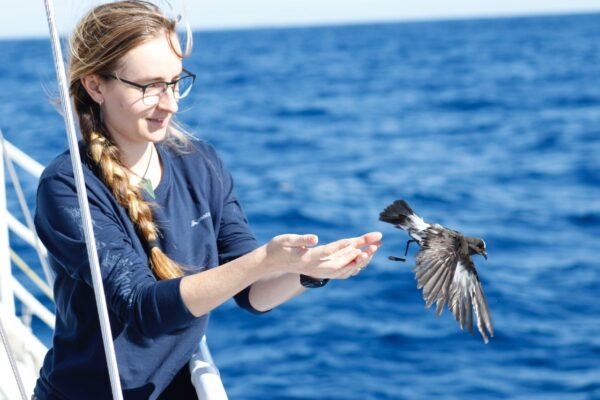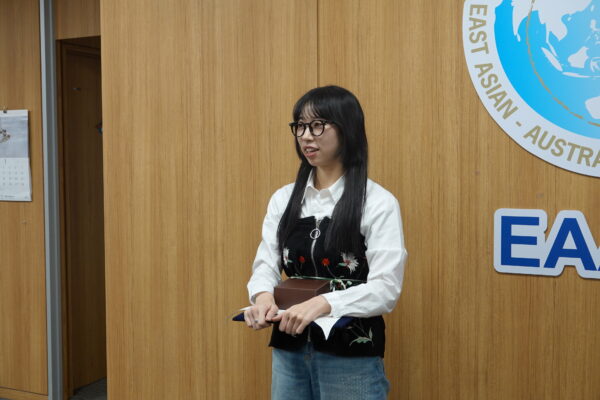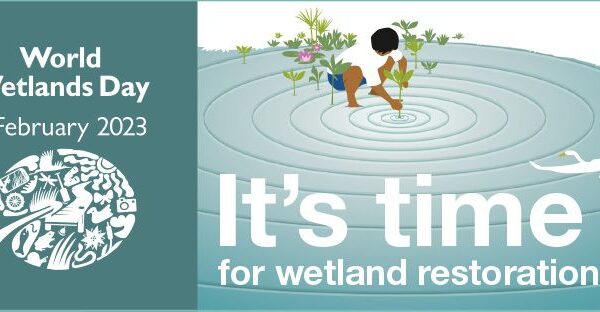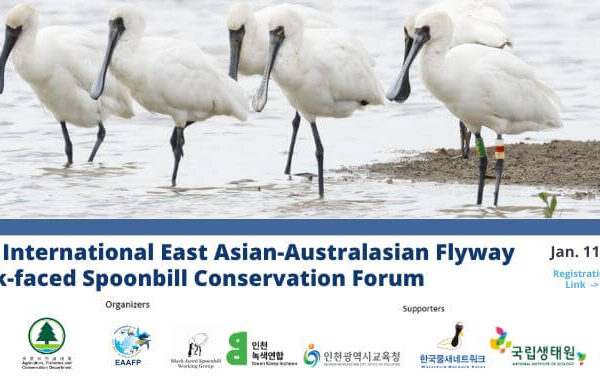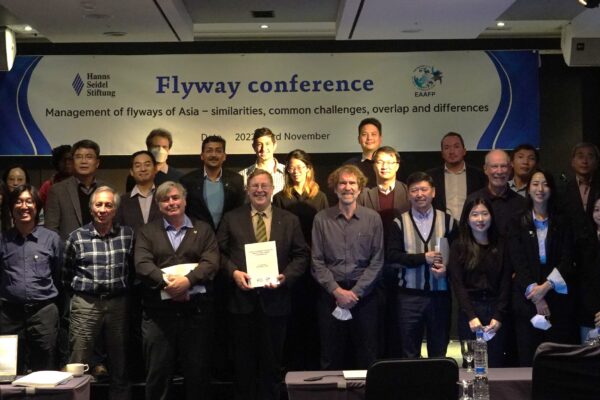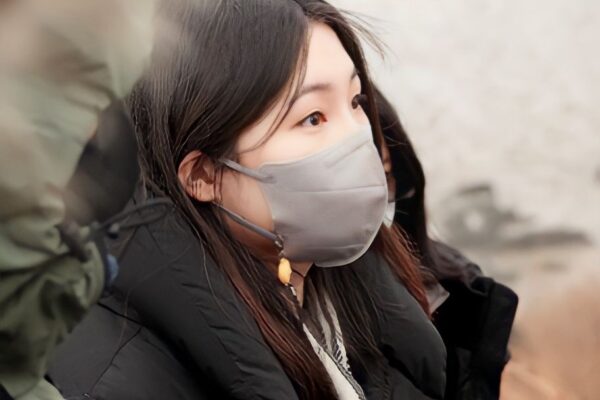-
Strengthen the local engagement in Baer’s Pochard conservation in central Myanmar
EAAFP Small Grant Fund Project…
Continue reading -
Working to conserve an endangered river-spirit: the Scaly-sided Merganser
EAAFP Small Grant Fund project by Nial Moores, Director, Birds Korea and IUCN SSC Threatened Waterfowl Specialist Group ©Nial Moores Sitting low in the water, close to the river bank, a Scaly-sided Merganser rests, half-hidden by the shade of an overhanging tree and by a line of jagged black rocks. Waking, the bird moves away from us quietly, and is soon joined by another and then another. Seen well, the details of each of these birds is exquisite: jagged crests, bright fire-red bills, and flanks with black and white fish-scales that mirror perfectly the ripples and reflections on the water. The Scaly-sided Merganser is a species that comes to Korea from the wildest river forests of East Asia, from summers in remote mountain valleys shared with the Siberian Tiger. They are shy, doing all they can to keep their distance from that most fearful of predators: people. They need fish to survive, caught in a series of shallow dives, often close to the river bank or in riffles where the flow is fastest. Each autumn, as the rivers further north freeze-over they have no choice but to move south; to spend the winter in landscapes that must now seem almost unrecognizable to them – curving, gurgling rivers dammed and dredged and straightened; cars and camp sites on shingle banks; formerly dark, silent forested banks spotted with private houses and coffee shops and restaurants playing the latest K-Pop music; quiet river bends, once safe refuges, made ever-more accessible to fast-moving packs of cyclists and hikers on paved highways, apparently oblivious to the exceptional biodiversity around them. Fewer and fewer places remain in the Republic of Korea (ROK) for the Scaly-sided Merganser, and for many of the species that share the same habitat: ground-nesting Long-billed Plovers and tree-nesting Mandarin Ducks, River Otters and freshwater turtles and endemic fish species. A whole suite of species confined to ever-smaller spaces; once connected ecosystems now fragmented. What can be done to slow down and then to reverse this decline in biodiversity, along Korean rivers and indeed in almost all the habitats on our increasingly degraded planet? Birds Korea is an active member of the East Asian-Australasian Flyway Partnership (EAAFP) Scaly-sided Merganser Task Force. We are small, but like so many environmental NGOs around the world, we do all we can to support decision-makers with best science; and to accelerate progress toward sustainability by offering solutions clarified through tailor-made plans and designs. For the Scaly-sided Merganser, this means first finding where the species can still survive, and then identifying the most efficient ways to reduce disturbance, river stretch by river stretch. In a world where quick economic returns are valued over sustainability, this means identifying ways in which local communities can genuinely benefit from conservation, be it through eco-tourism, local branding or subsidy support, as well as in helping build local pride. There is, as far as we know, still no fully protected stretch of river anywhere in the ROK which is 100% free from the threat of river-works and increasing disturbance. Nonetheless, 2022 has seen substantial progress. Funded by Yeoncheon County, we have been able to build on research in the Yeoncheon Imjin River Biosphere Reserve – a core area for the species during migration - to identify key stretches, to propose mitigation measures, and to raise awareness. And thanks to a small grant from the EAAFP and funding from the Hanns Seidel Foundation office in Seoul, we were also able to conduct our third national winter survey of the Scaly-sided Merganser, finding 175 individuals nationwide – about 4% of the estimated world population. We were also able to learn more about their migration strategy, counting 215 along three rivers in mid-November; and to hold the first workshop on the species, with wonderful activists sharing their insights. The EAAFP small grant also provided vital support for in-field training in identification and in counting, and in the production of an educational pamphlet Much remains to be done, of course. But the information gaps are closing, and more and more people now feel their deep connection to this wary, fish-patterned bird, to this endangered spirit of the river wild. The project was funded through the 2022 EAAFP WG/TF Small Grant Fund. View the report, Click here.
Continue reading -
Japan and U.S.A. announced Sister Site Agreement to strengthen collaboration to conserve migratory waterbirds
On 8th February, 2023, the Government of Saga City, Japan and the Bureau of Land Management (BLM)-Alaska signed the Memorandum of Understanding (MoU) establishing a Sister Site relationshipbetween Flyway Network Sites Higashiyoka-higata (EAAF 124) of Japan and Qupałuk (EAAF 133) of U.S.A. The agreement promotes closer collaboration on conserving migratory waterbirds. A virtual signing ceremony was held, with Mr. Hidetaka Sakai, Mayor of Saga City, and Mr. Steve Cohn, Alaska State Director, BLM signing the MoU. ©Saga City, Japan ©BLM Both Flyway Network Sites (FNSs) are important for migratory shorebirds, especially for Dunlin (Calidris alpine articola), which is the most abundant shorebirds in Japan, and Qupałuk is high quality nesting habitat. Under the EAAFP Flyway Site Network, the Sister Site Agreement encourages the two FNSs to cooperate in research and monitoring of species of common and their habitats, allow information exchange on conversation and habitat management. In addition, the agreement includes efforts on CEPA (Communication/Capacity Building, Education, Participation, and Awareness) activities to enhance exchange between the sites. Mr. Steven Cohn, State Director of BLM-Alaska expressed, "As managers of valuable nesting habitat, it is important for the BLM to collaborate with partners throughout the flyway to support holistic habitat management through the full life cycles of species. We look forward to this partnership with Saga City to coordinate on bird monitoring, habitat management, and education and outreach." Mr. Hidetaka Sakai, Mayor of Saga City, said, “I am delighted that we could establish this Sister Site partnership. The sites are not just essential for the migratory birds, but for our livelihoods as well, and in order to conserve them, it is necessary to have initiatives that go beyond borders. Through this sister site partnership, we will encourage people to think and act on a global scale regarding their conservation and sustainable use. I have high hopes that our efforts will lead to a prosperous future.” Dr. Keiichi Nakazawa, Director of Wildlife Division, Nature Conservation Bureau, Ministry of the Environment, Japan emphasized, “Higashiyoka-higata became the 33rd Flyway Network Site in Japan in 2016, and it is one of Japan's most prominent migratory stopover and wintering sites for waterbirds, including endangered species such as Saunders’s gull, Black-faced spoonbill, and Common shelduck; making a treasure trove of biodiversity. We are very pleased that Qupałuk and Higashiyoka-higata have concluded the Sister Site Agreement under the EAAFP, and we would also like to express our sincere respect for the conservation efforts made to date. Our ministry will continue to support initiatives conducted for the migratory waterbird conservation between the two wetlands.” Qupałuk is located in the northeast of Teshekpuk Lake in the northeast corner of the National Petroleum Reserve in Alaska on the Arctic Coastal Plain in Alaska, U.S.A. The site covers over 21,000 hectares of near-pristine tundra, wetland, and open water habitat. Qupałuk hosts approximately 30,000 total nesting migratory birds and is an important habitat for molting geese and eiders. The site is home to a high density of nesting Dunlin, with an estimated population of 6,000. It is the second Flyway Network Site in the U.S.A and is the first managed by the Bureau of Land Management-Alaska. To the Iñupiat people, the Alasak Natives who have lived harmoniously on this land for millenia, Qupałuk means “small shorebird”. Qupałuk © Kiliii Yuyan Located on the northern shore of the Ariake Sea in Japan, Higashiyoka-higata has the largest remaining area of tidal flats in the country. The 218-hectare mudflat regularly supports 1% of the flyway population of Endangered Black-faced Spoonbill and Vulnerable Saunders’s Gull, and more than 10,000 migratory waterbirds visit the site annually. Higashiyoka-higata was also designated as a Ramsar Site in 2015. The area used to be called Daijugarami and the traditional knowledge, techniques and food culture were retained and passed on for many generations. Higashiyoka-higata © Saga City, Japan The EAAFP Flyway Site Network was established to ensure a network of internationally important sites is sustainably managed to support the long-term survival of migratory waterbirds within the EAAF. To date, there are 152 Flyway Network Sites in EAAF. Under this network, the EAAFP Sister Site agreement offers a mechanism for Flyway Network Sites to collaborate closely on monitoring and research, capacity-building, sharing and exchanging information and experiences, and CEPA activities. Guidelines for the EAAFP Sister Site Program will be adopted during MOP11. More information Flyway Site Network: https://www.eaaflyway.net/the-flyway/flyway-site-network/ Sister Site Programme: https://www.eaaflyway.net/sister-sites/ Further reading https://alaskausfws.medium.com/a-little-birds-big-sisters-e071dfe57eac
Continue reading -
“Year of the Terns” Flyway Story Series #18 – Interview with Ms. Edin Whitehead
As EAAFP is designating 2022 the “Year of the Terns,” we are bringing great work and stories on tern conservation to you. The next story is from Ms. Edin Whitehead, who is a seabird scientist and conservation photographer in Aotearoa New Zealand. She was also a judge of the Year of the Terns Photo Contest (link). Photo of her releasing a New Zealand storm petrel @Jochen Zaeschmar EAAFP: Hello Edin, first of all, thank you once again for your effort as a judge to the Year of the Terns Photo Contest. Before we go deep, could you please tell us a little bit about yourself and your background? What brought you to studying seabirds and become a conservation photographer? Two things have always been constant in my life - a love of the outside world, particularly birds, and a love of creating. I started out sketching and painting, and eventually started joining my Dad on birdwatching trips that have morphed into bird photography trips over the years. It’s something we both love to do. I actually started studying Fine Art at university before switching to biology – so I could go on field trips around Aotearoa! I fell in love with seabirds – particularly petrels and albatrosses – after going to sea for the first time. The science and photography parts of my life have just started to combine into a career, and I value being able to use my photographs to share seabird science stories, and advocate for their conservation. EAAFP: We heard that you have recently released a book, Brilliance of Birds. Could you please introduce it to our audience and are there any highlights you would like to share? The Brilliance of Birds was published in 2019 by Penguin Random House New Zealand. It was a collaborative project between me and Skye Wishart, and we like to call it a bit of a celebration of some of the unique bird species that call Aotearoa home. There’s a mix of native and endemic species, as well as some of the introduced ones that people see every day, and we tell stories about their behaviours and biology, as well as their histories and cultural importance. I had so much fun working on the photographs for that book – I spent a year travelling around the country on ‘birdventures’ to meet species I’d never seen before. One of my most special memories from that time was photographing tarapirohe – Black-fronted terns – in the early spring snow in the Eglinton Valley in Fiordland. EAAFP: We found that you have also prepared a report on “Threats to Seabirds of Northern Aotearoa New Zealand” could you share with us the background on why this report was prepared and the processes behind it? Additionally, do you have any key messages from the report you would like to share? Seabirds are the most threatened group of birds in the world, and for well-targeted local conservation management, it’s important to understand which threats are most impacting the birds in your region. The report was put together to collate all the information we had for seabirds in the Northern Aotearoa region, and highlight the knowledge gaps about seabird biology and threats to seabirds that needed to be filled. It has since spurred a number of research projects, which is great. I think one of the key messages from the report was that we need to consider the whole ecosystem when doing conservation management – there’s no point in trying to restore seabird populations on land by controlling predator species if there’s no food in the marine habitat to sustain them. EAAFP: What was the most memorable moment during your expeditions? That’s a difficult question! One of my favourite research expeditions in the past few years was volunteering on a project catching New Zealand storm petrel at sea for a genomics study – to understand if there might be hidden populations on different islands. At the moment, Te Hauturu-o-Toi (Little Barrier Island) is the only place they’re known to breed. Capturing these tiny birds at sea is really tricky! It was hard work, and we would work into the evening if the conditions were calm enough. One evening the sea was like a mirror, and being out in the dinghy to catch the birds was like floating inside a huge prism of pinks and purples, with these tiny black-and-white birds dipping along the surface. There were a few Antipodean albatrosses cruising past as well. I took lots of photographs, but none of them really do justice to how beautiful it was. We caught one last bird just after the sun had set. Storm petrel at sea @Edin Whitehead EAAFP: On your webpage it says you “combine science and storytelling to help people explore our natural world” could you share with us an example of one of these stories? One of my long-term projects is to illustrate and share the lives of the seabirds that live around northern Aotearoa – particularly in Tīkapa Moana, the Hauraki Gulf. There are 27 species of seabirds that breed here, and many of them are species that people will never see unless they go out on the water, sometimes quite far offshore. I want to share the wonder I have in this remarkable diversity, and get people excited about these birds – most people don’t even know that there is a species here that has come back from being thought extinct for over 100 years – the New Zealand storm petrel. I’ve been really lucky to be involved in some of the research on this beautiful little bird, so I get to share some of the behind-the-scenes of seabird science. It’s a topic I often speak on, and I even work it into my photography talks! EAAFP: As a conservation photographer, are there any tips or words of caution you would like to share with other photographers? I think in a world where photography seems to have morphed into a ‘content-creation’ craze on social media where people do anything for ‘likes’, it’s really important to look at what value your photography gives back to the ecosystems that you work in. Ethical wildlife photography, honesty in captioning, and advocating for conservation are all crucial to this. EAAFP: Seeing your online gallery, we see many photos of albatrosses, are they your favorite Seabird Species? Could you share about your favorite seabird? I do love albatrosses and petrels! Their lives fascinate me – how they live far out on the ocean and make huge migrations around the world. I find it hard to say I have one favourite species, but I do have a soft spot for tiny little storm petrels – like the New Zealand storm petrel or White-faced storm petrel. They live in the same wild seas that albatrosses do, but they’re so much smaller and I find their resilience truly remarkable. EAAFP: Lastly, we know you wear many hats as a Doctoral Candidate at the University of Auckland, a conservation photographer, a blogger, an explorer in expeditions and more. How do you balance everything? There is a lot of overlap! I spend time on my own research trips making photographs that I use to communicate conservation issues. Sometimes I do have to prioritise what is most important – my blog has fallen a bit quiet as I work on writing up my thesis at the moment. Grey-faced petrel in purple bag @ Chris Gaskin
Continue reading -
Farewell to Yoonjin Lee, Administration & Finance Assistant
In the words of Yoonjin Lee, @EAAFP Secretariat "As an International Studies major, I have been interested in working in an International Organization. I had experiences with working with the embassy and foreign banks, so I thought it would be a good opportunity to widen my understanding of IO operations and use my knowledge and skills on operations of the organization. I dealt overseas transaction, maintenance of the officers and interns, and overall backup of the operations. My duties include variety of different genres. First one would be the maintenance of the office. For smoother operation of other teams, the Administration Intern would set up computer and the office gadgets. Preparing and ordering office supplies and communication between the Ministry of Environment and the Incheon City Government is also crucial. Second, backup for Administration officer, Chief, and the Deputy is also important. Translation of speeches for Chief or Deputy, and translation of official documents are required when such documents have to be circulated among the office. Lastly, and a finance intern, one will be taking responsible of overseas transaction and keeping track of the remittance. Small Grant Fund, Honorarium, and Forums need swift transaction with backing up document. She will be asked to keep track of the whole operation and leave marks regarding the money transfers. As a student, I was very embedded in environmentalism activities. In most part of my life, I also wanted to work in international cooperation domain for bigger understanding of the tasks that lies in front of the humankind. When I got the job as an intern, I expected to gain some insights within the genre of international organization, and I can proudly say that I had an amazing opportunity to work with team of professionals who are passionate with the agenda of the organization. While working in the EAAFP, I have worked in the genre of administration and finance. Even though I had some experiences in such domain prior to the internship, by working in international organization, I was able to gain higher understanding of the overall operation of the Secretariat. Dealing money and chasing the transaction tells you pretty much everything about the operation, and I had tracked most part of the transaction back and forth to the Secretariat. With the bigger understanding of the operation, I was able to see the mechanism that the staff members were dedicated to. The officers and the interns are very enthusiastic when it comes to executing the program that the Secretariat puts vision into. They are very concentrated, and highly passionate people who believe that their operation could, and would bring difference into this planet. Their dedication and understanding of the agenda had me look back at myself and my future that I have set for myself. I believe this experience in EAAFP made me find the passion that I might have lost."
Continue reading -
World Wetlands Day 2023: It’s Time for Wetlands Restoration
World Wetlands Day is celebrated every year on 2 February, to commemorate the date of the adoption of the Ramsar Convention…
Continue reading -
Move forward for Black-faced Spoonbill Conservation in EAAF
Discussing the expanding the Sister Site Program at the 3rd Incheon-Hong Kong International East Asian-Australasian Black-faced Spoonbill Conservation Cooperation Forum From 11 to 13 January 2023, the Environment Bureau of Incheon Metropolitan Government and the Agriculture, Fisheries and Conservation Department (AFCD) of Hong Kong Special Administrative Region co-hosted the “3rd Incheon-Hong Kong International East Asian-Australasian Black-faced Spoonbill Conservation Cooperation Forum”, with the EAAFP Secretariat and EAAFP Black-faced Spoonbill Working Group, Green Korea Incheon and Incheon Metropolitan City Office of Education as co-organizers. The Forum was a part of the action under the Sister Site Program Agreement between Songdo Tidal Flat (EAAF145), Incheon Metropolitan City, the Republic of Korea, and Mai Po Nature Reserve (EAAF003), Hong Kong Special Administrative Region, the People’s Republic of China, which was signed in 2019 (link). With the mission to collaborate with the conservation of the endangered Black-faced Spoonbill (BFS) in the East Asian-Australasian Flyway, representatives from both Incheon and Hong Kong, as well as representatives of Japan, the People’s Republic of China, and Vietnam shared the outputs in 2022 on relevant activities, reported the results of Black-faced Spoonbill monitoring and study on their habitats and winter census, and the current conservation activities for BFSs in Incheon and Hong Kong. As an extension of the previous forum, a sub-forum on environmental education also took place in this forum. During the 3-day forum, around 150 participants joined both online and on-site, including government officials, local NGOs, experts, and researchers from countries in EAAF. Day 1: The Environmental Education Subforum Group photo on Day 1 © EAAFP Secretariat The Environmental Education Sub Forum o1 began with opening remarks from Ms. Seheon Kim, Director of the Environment and Climate Policy Division at the Environment Bureau of Incheon Metropolitan City, through Mr. Seohyeon Park who read her speech on behalf. Ms. So Young Han, Senior Supervisor of the Incheon City Office of Education, Dr. Flora Mok, Senior Conservation Officer of the Biodiversity Conservation Division, AFCD, and Mr. Chris Rostron, the EAAFP CEPA Working Group Vice Chair who gave keynote presentation on CEPA in EAAFlyway Following their remarks was the first session of the sub-forum in which three speakers gave presentations overviewing Environmental Education in Ro Korea, China, and Hong Kong. Professor Jaeyoung Lee of Gongju University gave the first presentation, discussing the “Achievements and Remaining Tasks for Environmental Education in Ro Korea.” In his presentation, Professor Lee went over the history of Env. Edu. in Ro Korea and discussed the recent changes in laws for Env. Edu. His presentation concluded with the current trend of Env. Edu in Ro Korea focuses on promoting how our Society is interlinked with Natural and Ecological Systems. The following presentation was from Ms. Huizhe Hu, Mangrove Foundation, who overviewed Env. Edu in China. In her presentation, Ms. Hu shared how, starting 2005, national wetland parks in China have expanded, with more than 900 parks in 2022. Various Environmental Education programs are organized and run through those parks. She also discussed the Environmental Education work done by the National Forestry and Grassland Administration of China and the “The Wetland Conservation Law of the People’s Republic of China”. Dr. Vicky Choi from the Agriculture, Fisheries, and Conservation Department of Hong Kong (AFCD) overviewed Hong Kong’s Env Edu. In her presentation, Dr. Choi briefly introduced the Hong Kong Biodiversity Strategy and Action Plan and the funding programs from the AFCD for conservation activities, including CEPA. She also shared other Env Edu online and offline activities and programs organized in Hong Kong. The second session of the Env. Edu. Sub-forum focused on Environmental Education in formal education. This is related to the newly adopted Ramsar Resolution on Wetland Education in Formal Education (link).It began with a presentation from Ms. Wonju Kim of Upo Ecology Education Institute, which was one of the leading institutes in drafting this Resolution , which was proposed at Ramsar COP 13 and its adoption process; it was adopted last year at Ramsar COP 14. She also further discussed the plans for its implementation in RO Korea and concluded by exploring the direction the resolution should take in the future. Afterward, Ms. Sunjeong Nam from the Incheon Metropolitan City Office of Education presented an overview of Wetland Education Programs led by the Incheon Metropolitan City Office of Education. After briefing and introducing the status of Wetland Education in Incheon City, she discussed a few programs in more detail, such as building forests and small wetland ecosystems in schools. She also shared programs the Office of Education offered in collaboration with various local NGOs before concluding with a sneak peek into the plans and programs the Office of Education was planning for 2023. The final presentation session for the forum was on Env. Edu. at wetlands for the general public, the role of NGOs and wetland centers. Ms. Catherine Lam of AFCD briefly introduced Hong Kong Wetland Park and its facilities. Afterward, she discussed the various awareness-raising educational programs organized at the Wetland Park for different target audience of the visitor types. Mr. Yamme Leung Director, Education, WWF-HK shared that WWF-HK’s Environmental Education focuses primarily on its programs at Maipo Nature Reserve (NR). He briefly went over the reserve's management goal and education mission, where they aimed to offer “Education for all.” He then shared the different programs offered at Mai Po NR. After sharing from Hong Kong, Ms. Mieun Kim from ‘Black faced Spoonbill and Friends (BfS & Friends)’ presented the Environmental Education work done in Incheon, Ro Korea, by the local NGO, BfS and Friends. The organization is currently running the BfS Eco Center organizes programs such as citizen monitoring programs as well as others in collaboration with other NGOs who are a part of the BfS network. BfS and Friends also run programs in cooperation with Incheon City, such as the mobile Climate school programs for students and schools. Ms. Juhee Park from Green Korea Incheon closed the third session by discussing the necessity and role of wetland sites or centers as hubs for conservation activities. In her presentation, Ms. Park briefly overviewed the wetlands in Incheon, which makes up around 29.3% of Ro Korea’s tidal flats. She then brought Yeongjong Tidal Flat and Daejak Island to show how these sites became crucial hubs for conservation activities. With moderation by Ms. Vivian Fu, Senior Communication Officer of EAAFP, Day 1 of the forum concluded with a combined Q & A and discussion session. Participants discussed plans for expanding their networks and how to communicate and share materials and information effectively. Ms. Junghee Park from Green Korea Incheon gave a closing remark to explain the meaning of both the sub-forum and the main forum the next day. Day 2: Main Forum on International Black-faced Spoonbill Conservation Corporation Forum Group photo on Day 2 © EAAFP Secretariat The Main Forum started with opening remarks from Mr. Simon Chan, Assistant Director (Conservation) of Agriculture, Fisheries and Conservation Department (AFCD) of Hong Kong Special Administrative Region, Ms. Seheon Kim, Director of the Environment and Climate Policy Division at the Environment Bureau of Incheon Metropolitan City (delivered by Mr. Seohyeon Park), and Mr. Doug Watkins, Chief Executive of EAAFP Secretariat. After the remarks, Ms. Hyeseon Do, Senior Programme Officer of the EAAFP Secretariat moderated the presentation session. Ms. Yeonah Ku, Local Project Coordinator, and Ms. Vivian Fu, from EAAFP Secretariat, introduce the EAAFP Sister Site Program and its outcome and CEPA activities supported by the Secretariat. Ms. Ku mentioned that the forum, as the outcome of the Sister Site Program, is meaningful, and further participation from the countries in EAAF would be appreciated. In the second presentation, experts from Hong Kong and the Republic of Korea shared the reports on the international Black-faced Spoonbill census result. Mr. Yat-tung Yu, Director of the Hong Kong Bird Watching Society and Coordinator of the EAAFP BFS Working Group, shared the work and results of the international Black-faced Spoonbill winter census. Dr. Kisup Lee, Director of Waterbird Network Korea and Chair of EAAFP BFS Working Group shared the 2022 summer census on BFS in ROK. Mr. Seonghyeon Park from the Environment and Climate Policy Division at the Environment Bureau of Incheon Metropolitan City presented on the ecological status and the Incheon Conservation Guild of Black-faced Spoonbills. He introduced several programs run by the Black-faced Spoonbill Ecological Learning Center. Ms. Joyee Chan of AFCD Hong Kong introduced conservation work in Mai Po Inner Deep Bay of Hong Kong. She emphasized the ecological importance of Mai Po Inner Deep Bay as one of the main habitats for Blakc-faced Spoonbills. She also mentioned plans for Black-faced Spoonbills conservations, which is currently under review. In the fourth and last presentation session, speakers from EAAF countries shared their outcomes and experiences on Black-faced Spoonbill conservation. Mr. Shigeki Takano from Japan BFS Network introduced the main wintering sites in Japan and Black-faced Spoonbill Regional Project. Secondly, Dr. Zhang Guogang from China Bird Banding Center shared his presentation on important distribution sites and autumn migration routes of Black-faced Spoonbills breeding in Liaoning Province. Thirdly, Ms. Phung Thu Thuy from Nature Biodiversity Conservation Agency Vietnam focused on sharing institutional strategies to conserve endangered Black-faced Spoonbills. Fourthly, Dr. Jong-Kyeong Hwang from the National Institute of Ecology mainly shared conservation efforts in Incheon, based on the Incheon Conservation Guild of Black-faced Spoonbills. Lastly, Mr. Hongtae Jeon from Seocheon County presented on Black-faced Spoonbill monitoring as one of the Flyway Network Sites of EAAFP. Day 2 of the forum concluded with a Q&A and Group Discussion session, moderated by Mr. Yat Tung Yu. Based on the contents of the presentation, both online and on-site participants shared their opinion. Participants discussed plans about a potential International Black-faced Spoonbill Network based on the Sister Site Program. Other sites’ participation in the existing Sister Site Program was discussed based on Black-faced Spoonbill, where Incheon and Hong Kong have been participating. EAAFP Sister Site Program and the conservation networking groups for cranes will be good references or tool to move forward. CEPA action, on the other hand, will be a medium to connect sites, people, groups to promote the Black-faced Spoonbill conservation. On day 3 of the forum, Green Korea Incheon organized a tour for participants to visit Black-faced Spoonbill breeding sites in Incheon, inclduing Yeongjong, Ganghwa Island, and Namdong Reservoir, . . Group photo on Day 3 © EAAFP Secretariat For the forum programme and information: click here. EAAFP Sister Site Programme:: Download [Korean version] 저어새 보전을 위한 다음 단계로 향해 - 제3회 인천-홍콩 국제 동아시아-대양주 철새이동경로 저어새 보전 협력 포럼에서 EAAFP 자매서식지 프로그램 확장을 논의하다 2023년 1월 11~ 13일, 인천광역시 환경국과 홍콩특별행정구 농어업자연보전국에서 주최하고 동아시아-대양주 철새이동경로 파트너십(EAAFP) 사무국, EAAFP 저어새 워킹그룹, 인천녹색연합, 인천광역시 교육청에서 공동 주관하여 “제3회 인천-홍콩 국제 동아시아-대양주 철새이동경로 저어새 보전 협력 포럼”을 개최하였다. 본 포럼은 2019년부터 진행된 인천광역시와 홍콩특별행정구 사이의 자매 서식지 결연 프로그램의 일환으로 개최되었다. 동아시아-대양주 철새이동경로 내의 저어새 보전이라는 공동 목표를 위하며, 인천과 홍콩은 물론 일본과 중국, 베트남 참가자들이 2022년도에 진행되었던 관련 활동을 공유하고 추적 결과와 서식지 관련 연구 및 동계 개체수를 보고하였다. 인천과 홍콩에서의 보전 활동 또한 발표의 한 축을 담당하였다. 지난 포럼에서 논의되었던 내용의 연장선상으로서 환경교육 부속포럼 또한 개최되었다. 150명 가량의 온라인 및 현장 참여자들이 3일간의 포럼에 참여하였으며, 참가자는 정부 관계자, 지역 NGO, 동아시아-대양주 철새이동경로 내의 전문가와 연구자들을 포괄하였다. 1일차에 진행된 환경교육 부속포럼은 인천광역시 환경국 기후환경정책과 김세헌 과장(박성현 팀장 대독)의 개회사로 문을 열었으며, 인천광역시 교육청의 한소영 장학관, 홍콩특별행정구 농어업보전국 생물다양성 보전과 수석 보전 담당관 플로라 목, EAAFP CEPA(대중인식제고활동) 워킹그룹 부의장인 크리스 로스트론의 개회사를 통해 그 시작을 알렸다. 개회사 뒤에 이어진 첫 번째 세션에서는 3명의 연사자들이 대한민국과 중국, 홍콩에서의 환경교육을 개괄적으로 다룬 발표를 진행하였다. 공주대학교의 이재영 교수는 ‘한국 환경교육의 성과와 과제’를 주제로 발표하였다. 대한민국 내에서의 환경교육의 역사와 최근 환경교육 관련 법안에서의 변화가 주로 언급되었으며, 최근 환경교육의 기조인 사회와 자연 및 생태계의 연결성에 대해 논의하는 것으로 발표를 마무리하였다. 맹그로브 재단의 허 후이저 수석교육연구원은 중국의 환경교육에 대해 발표했다. 발표는 중국의 국립 습지 공원의 수가 2005년에 비해 빠른 속도로 증가하였는지를 다루었으며, 이렇게 조성된 습지 공원들이 추후 환경교육의 면에서 맡을 수 있는 역할을 시사하였다. 중화인민공화국의 습지보전법에 의해 국가임업초원국에서 진행하고 있는 여러 환경교육 활동 또한 공유하었다. 홍콩 농어업보전국의 비키 최 담당관은 홍콩 내의 환경교육을 조망하였다. 홍콩의 생물다양성 정책과 액션 플랜 및 투자 프로그램을 기조로 한 보전 활동들이 공유되었으며, 홍콩에서 진행되는 온라인 및 오프라인 교육 활동의 내용 또한 소개되었다. 환경교육 부속포럼의 두 번째 세션은 공교육 내의 환경교육에 초점을 맞추어 진행되었다. 경상남도교육청 소속의 우포생태교육원 김원주 교사의 발표가 두 번째 세션을 열었다. 발표에서는 제13회 람사르 총회에서 제안된 공교육 내 습지교육 결의안과 제14회 총회에서 채택된 해당 결의안이 주로 언급되었다. 한국 내에서의 실행 계획과 방향성 또한 발표 중 비중있게 논의된 바 있다. 둘째로, 인천광역시 교육청의 남선정 장학사는 인천광역시 교육청에서 진행하는 습지교육을 개괄적으로 소개하였다. 습지 교육에 대한 소개 이후로는 숲 조성 또는 학교 내 습지 생태계 조성 등의 상세 프로그램 또한 논의되었다. 발표는 교육청에서 지역 NGO들과 연계하여 진행하는 교육 프로그램을 공유한 후, 2023년도 사업계획을 간략히 언급하는 것으로 끝맺었다. 포럼의 마지막 발표 세션은 일반 대중 대상 습지 환경 교육에서 비정부 기구와 습지 센터의 역할을 논의하는 것에 집중했다. 홍콩특별행정구 농어업보전국 홍콩 습지공원 소속의 캐서린 램 담당관은 홍콩의 습지 공원과 습지 센터를 간략히 소개했다. 이후에는 대중 인식 제고를 위해 습지 공원들에서 다양한 관람객의 수요를 충족하고자 조직된 다양한 교육 프로그램이 조망되었다. 세계자연기금 홍콩의 얘미 릉 교육국장은 마이포 자연보호구역에서 진행되는 프로그램들에 초점을 맞추어 발표를 진행하였다. 발표 중에는 운영상의 목표와 자연보호구역 내의 교육 목표인 ‘모두를 위한 교육’이 간략히 논의되었으며, 해당 목표들 아래 운영되는 프로그램 또한 소개되었다. 저어새와 친구들 김미은 사무국장은 지역 NGO인 저어새와 친구들에서 인천을 기반으로 진행하는 환경교육 활동을 중심으로 발표를 진행하였다. 해당 단체는 시민 모니터링 프로그램과 같은 프로그램을 운영하는 저어새 생태 센터를 운영함은 물론, 저어새 네트워크의 일환으로 다른 NGO들과의 협업을 진행 중에 있다. 저어새와 친구들은 학교와 학생을 위한 이동식 기후 학교를 운영하는 등 인천광역시와도 협업 활동을 운영하고 있으며, 프로그램의 개요와 골자가 발표 중 언급되었다. 인천녹색연합의 박주희 사무처장은 습지 서식지와 센터를 보전 활동의 구심점으로 삼아야 한다는 논의를 이끌며 세 번째 세션을 마무리하였다. 발표에서는 대한민국 전체 갯벌의 약 29.3%를 차지하는 인천 갯벌을 강조함은 물론, 영종 갯벌과 대작도의 사례를 중심으로 어떻게 해당 서식지들이 보전 활동의 중심이 되었는지가 다루어졌다. 포럼 1일차는 질의응답과 토의 세션으로 마무리되었다. 해당 세션에서 참여자들은 네트워크의 확장과 물질적, 정보적으로 효율적인 소통에 대해 이야기를 나누었으며, 미래 계획을 끝으로 세션을 마무리하고 다음을 기약하였다. 1일 포럼의 마무리 말씀을 인천녹색연합 박정희 공동대표가 하였으며, 다음날 진행될 국제포럼을 또한 소개하였다. 2일차의 국제 포럼은 홍콩특별행정구 농어업보전국의 사이먼 챈 농업과장의 개회사를 통해 그 시작을 알렸다. 1일차에 이어 인천광역시 환경국 환경기후정책과 김세헌 과장도 개회사를 진행하였으며, 동아시아-대양주 철새이동경로 파트너십(EAAFP) 사무국의 더그 왓킨스 대표 또한 축사를 전달하였다. 개회사 이후에는 EAAFP 사무국의 도혜선 프로그램 담당관이 사회를 맡아 포럼의 발표 세션을 진행하였다. EAAFP 사무국의 구연아 프로젝트 코디네이터와 비비안 푸 수석 커뮤니케이션 담당관은 EAAFP의 자매 서식지 프로그램과 그 성과는 물론, 대중인식제고(CEPA)활동 또한 소개하였다. 구 코디네이터는 자매 서식지 프로그램의 성과로서의 포럼은 개최 그 자체로 의미가 있으며, 동아시아-대양주 철새이동경로 내의 국가들에서도 더 많은 참여를 바란다는 소회를 밝혔다. 두 번째 발표 세션에서는 인천과 홍콩의 전문가들이 국제 저어새 개체수 조사 결과를 보고하였다. 홍콩야생조류관찰협회의 국장이자 EAAFP 저어새 워킹그룹의 코디네이터인 유얏퉁 국장은 국제 개체수 조사 결과를, 물새네트워크의 대표이자 EAAFP 저어새 워킹그룹의 의장인 이기섭 대표는 2022년도 하절기 대한민국에서 진행한 개체수 조사 결과를 보고하였다. 인천광역시 환경국 기후환경정책과의 박성현 팀장은 인천의 저어새와 물새 보전 활동을 생태학적 현주소를 중심으로 발표하였다. 저어새 생태 학습 센터에서 운영되는 여러 프로그램 또한 소개되었다. 홍콩특별행정구 농어업보전국의 조이 챈 습지 및 동물 보전 담당관은 홍콩의 마이포 습지에서 진행되는 보전 활동을 소개하였다. 발표 중에는 저어새의 주요 서식지 중 하나로서의 마이포 습지의 중요성이 역설되었으며, 현재 논의 중에 있는 저어새 보전을 위한 향후 계획 또한 간략히 언급되었다. 네 번째이자 마지막 발표에서는, 동아시아-대양주 철새이동경로 내 국가들에서 온 발표자들이 저어새 보전 활동 경험을 공유하고 성과를 소개하였다. 일본 저어새 네트워크의 타카노 시게키 전 대표는 일본 내 저어새의 주요 월동지와 저어새 보전을 위한 지역 포스터 프로젝트 등의 활동을 소개하였다. 중국조류밴딩센터의 장궈강 부국장은 중국 내 저어새의 주요 분포지를 소개함은 물론, 랴오닝 성 내 번식하는 저어새의 가을철 이동 경로를 발표하였다. 베트남국립생물다양성보전협회의 풍투투이 주무관은 멸종 위기의 저어새 보전을 위해 베트남에서 시행하고 있는 여러 제도적 장치를 소개하였으며, 마찬가지로 베트남 내의 주요 저어새 서식지와 그곳에서 진행되는 보전 활동을 소개했다. 넷째로, 국립생태원의 황종경 박사는 인천 저어새 공존협의체의 보전 활동의 초점을 맞추어 인천에서 진행되는 저어새 보전 활동을 공유하였다. 마지막으로, 서천군 관광축제과의 전홍태 주무관은 EAAFP의 철새이동경로 네트워크 서식지로서 진행한 저어새 모니터링 및 보전 활동을 소개하였다. 포럼 2일차 또한 질의응답과 그룹 토의 세션으로 마무리되었다. 발표 내용에 기반하여 온라인과 현장 참여자 모두 활발히 의견을 공유하였으며, 참여자들은 자매 서식지 프로그램에 기반한 국제 저어새 네트워크에 대한 미래 계획을 논의하였다. 저어새를 중심으로 자매서식지가 인천과 홍콩 두 도시를 포함하여 더 많은 서식지의 참여가 가능하며, 앞으로 EAAFP 총회에서 채택하게 될 자매서식지 프로그램 지침, 현재 활발히 이뤄지고 있는 두루미 보전 네트워크 등의 활용 또는 참조하자는 의견이 있었다. 또한 CEPA 활동을 통하여 저어새 활동을 널리 알리고 연결을 돕는 매개체가 될 것이다. 포럼 3일차는 현장 답사 프로그램을 중심으로 진행되었다. 참여자들은 인천광역시 내의 저어새 서식지를 방문하여 생태를 관찰하였으며, 답사 장소는 송도와 영종도, 강화도를 중심으로 구성되었다. 답사 프로그램 전반은 인천녹색연합의 주관으로 조직되었다. 발표자료 공개: Download
Continue reading -
Conference on Management of Flyways in Asia
On 23rd November 2022, EAAFP Partner, Hanns-Seidel Foundation (HSF) and the East…
Continue reading -
Farewell to Yoomi Sim, Communication Assistant
In the words of Yoomi Sim, "As an English Literature and American Culture Double Major, I felt that I did not have enough background and knowledge to pursue the career I wanted; to work at an International Organization that focused on the Environment. Internship opportunities at other environmental organizations available at the time, were only open to individuals with related majors, such as biology or international relations. The Communication Assistant position at the EAAFP Secretariat, however, was open to all majors and seemed like the perfect Segway for me. Furthermore, being a Communication Assistant meant that I could bring the skills I studied as an English major to my work such as writing speeches, articles for the EAAFP website, drafting SNS posts and other written tasks. My familiarity with English also helped in translation and interpretation tasks throughout the internship period and came in handy when communicating with various people who visited our booths at different events. Yoomi Sim ©Eugene Kim / EAAFP As a Communication Assistant my main task was to become the bridge between the Secretariat and the public, conveying the Secretariat’s messages through various media outlets such as SNS, speeches and even a local news article. To do so, I helped manage EAAFP SNS channels, website, and monthly eNewsletter. Another important task as a Communication Assistant was to support CEPA activities and campaigns organized by the Communication Team. I mostly helped take lead in projects for World Migratory Bird Day (WMBD) such as creating the light pollution factsheet standing banner or managing the Small Grant Fund for WMBD. I also supported the Youth Think Tank Competition and helped organize its various online workshops and closing ceremony; I became a co-moderator for one of the workshops. Other than these two main activities, I also helped support CEPA activities under the Incheon-Hong Kong Sister site programme and helped in the production of the Korean Version of the Black faced Spoonbill Lolo’s Flying Journey Education Pack, supported the following Environmental Education Workshop and helped during the EAAFP Black Faced Spoonbill Conservation Forum. As an intern I also completed other tasks such as sending out the annual EAAFP calendars, writing meeting minutes for various meetings such as the monthly CEPA Working Group meetings and the Partner’s Workshop, running EAAFP booths at invited events, writing briefing notes and trip reports for business trips and other simpler tasks such as setting up the meeting room for student visitors, giving presentations about EAAFP and taking photos to name a few. Taking a quiet moment to write this article gave me the opportunity to fully embrace all that has happened the past year. With an extremely busy and eventful 1-year at EAAFP, I never had a chance to take in all we have done and accomplished. Going through a year worth of photos and materials I realize how much I have learned, experienced and grown as a person. EAAFP Christmas Party © EAAFP Secretariat One of the most important lessons I take away from this internship is learning that everyone can do something for the environment where they are with whatever skills they have, whether it is language skills or business skills. When first joining EAAFP, I had thought the only real way to make changes for the environment was through scientific methods. However, after experiencing firsthand how communication and education can also make a difference, I realize there are many more paths I can take for conservation other than becoming a researcher. The internship also gave me valuable opportunities to learn basic working and management skills, starting as a newbie intern on the first day to later becoming a senior intern guiding and leading newer interns. It also gave me insight on how international organizations work and collaborate with each other, as well as giving me experience in organizing and attending events at both domestic and international levels. Through these opportunities and experiences, I feel I am much better armed and ready for a career at an international environmental organization. EAAFP Secretariat at the IUCN Leader’s Forum © EAAFP Secretariat One of the most valuable takeaways from this internship would definitely be the people. As an intern at the Secretariat, I had the opportunity to meet people from different environmental sectors at various levels, speaking with them, hearing about their experiences and learning. The best, however, would be the wonderful Secretariat staff. Our amazing officers and staff members who have helped not just me, but other interns grow, learn, and find our own footholds and paths to our futures. I would like to sincerely thank them all for their encouragement and guidance. Our warm and lively interns also is what makes the experience so valuable. Meeting other like-minded youths who are driven, and passionate helps inspire and motivate everyone who meets them. EAAFP Staff Retreat © Yoomi Sim / EAAFP Moving onwards from this internship, I am no longer scared but excited to take the steps forward into the future. I hope to stay closely in touch with everyone I have met and look forward to seeing all the wonderful things they will accomplish, hoping that we can once again work together to continue making changes for the environment. To possible future interns for the EAAFP Secretariat who are unsure whether they should apply, I would like to encourage everyone to go ahead and take the opportunity. It will be a priceless experience."
Continue reading

